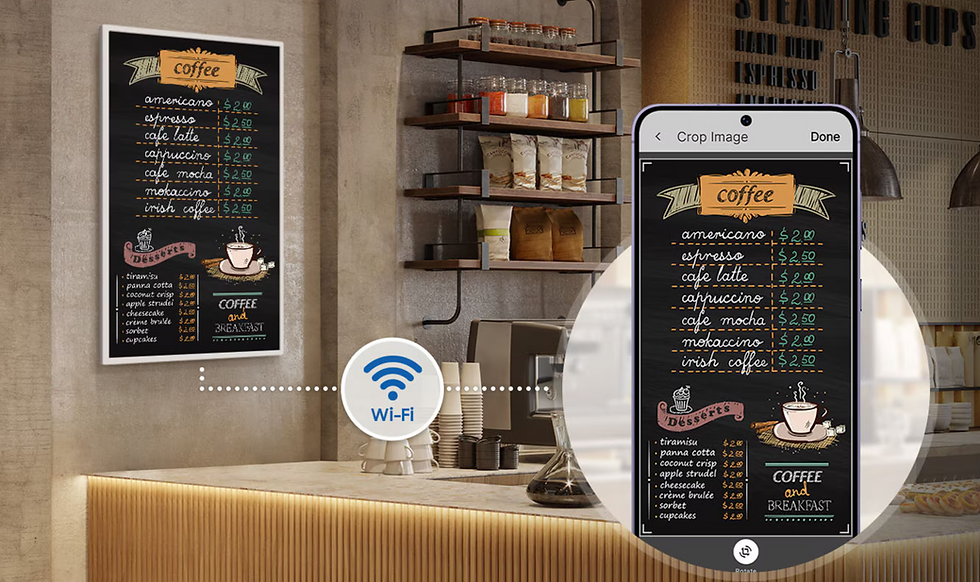The Power of Real-Time Data in Digital Signage
- Aks K
- Jul 16
- 4 min read

Digital signage content makes the greatest impact when it’s kept up-to-date. While the norm is to create campaigns meant to last for weeks, you may utilize content which refers to real-time events. Set up content reflecting the weather at any given moment of the day. You can even plan it out months in advance by setting up content to trigger automatically based on real-time data. Or you can have it on stand by to trigger manually when the need arises.
Time and weather information
The simplest example of information delivery in real time is displaying the current time and date. Nothing special about that, of course. Unless you tie it in with relevant events. Countdowns can build more excitement, pinpointing when a sale ends, or a new event starts. This information is tied to an approaching real-time event.
Likewise, weather information in general isn’t a topic people get excited about. However, real-time weather data can make things interesting if used effectively. One very serious example are safety alerts, such as heatwave warnings, storms, strong snow fall, etc. In terms of sale opportunities, some businesses push campaigns under the corresponding conditions. For example, advertising hot beverages on chilly days, or new ice cream flavors on hot ones.
With digital signage software, you can build campaigns and have them trigger based on data collected in the moment. This results in content based on real-time conditions!
News and social media
As you know your audience, you are able to easily identify online news sources they may be interested in. With RSS feeds via digital signage software, for example, you can deliver news on a consistent basis without having to create campaigns from scratch.
The headlines themselves might not be tailored to each viewer, but the act of delivering current information relevant to the audience leaves an impact. It keeps people informed, but it also builds up your image. Social media integration can add an additional layer for interactivity and engagement. Social wall apps are perfect for this purpose, creating professional campaigns built up of fresh content.
Inventory updates
A useful application of real-time data via digital signage is the status of your inventory. The same way users can browse your online store and see which items are out of stock, they could do that at the physical location. Setting up interactive displays is a great way to enrich the customer experience at the store and avoid losing their attention to their phones where they would otherwise have to turn to to find out.
There is also room for non-interactive campaigns, as displays can inform customers which products are soon running out of stock, when a re-stock is coming, which products are retiring, or which new products are coming. This sort of information creates a ton of opportunities for additional content. For example, if a customer requests an unavailable product, alternative products can be suggested via digital signage.
In case similar questions about products are asked repeatedly and you find yourself giving the same sales pitch every time, build a respective campaign to trigger in those times to feature the relevant products.
Smart triggers
An example of triggered content was covered above, with campaigns coming up under certain weather or time conditions. Taking this sort of content further, you can trigger digital signage content through pretty much anything.
Digital signage technology is highly compatible with other tech, such as motion sensors, for example. Once your system detects high traffic inside the store, displays can push time-sensitive offers, as well as display directions for a smoother flow. Then there is the topic of queue management where content plays when a long line starts forming. Another simpler example is to trigger a specific campaign an hour or two before closing time.
Don’t forget the direct approach of triggering content either. While it is not the most elaborate approach, your employees can trigger content on demand, either directly through the software you use to manage digital signage content, or via other methods. For example, you may set up a QR-code trigger which, when scanned by staff, displays a campaign. Consider highly specific campaigns such as evacuation procedures, technical issues, special events and so forth.
Scheduled content
Some portions of your digital signage content may be time-sensitive, but they don’t always have to be tied to unpredictable events. Keep in mind that there are many things you can predict when it comes to the behavior of your audience. People behave differently throughout the year, during holidays, seasons, and even days of the week. In many cases, you can even predict their behavior throughout the day.
Businesses such as restaurants can usually predict traffic spikes throughout the day. Grocery stores do this on a weekly basis, noticing some days as busier than others. Plan your digital signage content to match these patterns and schedule accordingly. The best part, as we said in our in-depth post on scheduling content, is that as you gradually plan for holidays and seasons throughout the year, you’re expanding your content library. A year later, you’ll have plenty of pre-made templates you’ll only need to tweak slightly, giving you tons of content to use years in advance.
Scheduling content is only a small fraction of what you can do through digital signage software. With OnSign, you can create content in more ways than one, utilize apps, templates, and more. Try it out!


